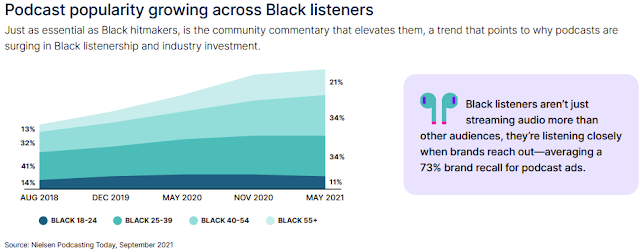According to “Seeing and Believing: Meeting Black audience demand for representation that matters,” the newest report in Nielsen’s Diverse Intelligence Series, the U.S. Black population has a complex and powerful legacy that continues to shape countries and cultures around the world. Yet, when it comes to representation in media, the complexity that creates the richness of their experience is often lost, and when present, undervalued.
As Black Americans continue to video stream, listen to radio and podcasts, as well as buy Black, they continue to lead the conversation and stay connected through social media — having an unprecedented impact on brands and what consumers watch, purchase, and listen to.
“As the media industry looks to be more inclusive of Black storytellers and brands look to grow their bottom lines and brand awareness with Black audiences, understanding who we are, where we’re connected, and how we’re changing is as important as ever. All of this work translates to the important acknowledgment of the value the Black community delivers ‘for the culture’ and beyond,” says Charlene Polite Corley, VP, Diverse Insights & Partnerships, Nielsen.
Key findings from the report include:
- Black America is taking control of both the economic and media influence they hold and they are using it to invest in Black experiences, Black communities, and Black content.
- Two out of three Black viewers are more likely to watch representative content and buy from brands that advertise in representative content.
- In 2020, Black Buying Power was at $1.57 Trillion.
- In 2021, Black viewing power was at 1.06 Trillion.
The urgency to get representation right is real—it’s a primary factor for the massive viewing levels Black audiences deliver and the shift in Black viewing power to platforms most representative of their community and identity group. But getting representation right is increasingly nuanced.
- According to the 2020 U.S. Census, 9% of America’s rural population is Black; 16% of Black people in the U.S. report speaking a language other than English at home; people identifying as “Black in combination with another race” increased 89% in the last decade; and Afro-Latinos are 8% of today’s U.S. Black population.
- 58% of Black audiences say there’s still not enough representation of their identity group on screen.
- Nearly a quarter of the reported genres in Gracenote Inclusion Analytics reported zero representation of Black talent in recurring lead roles.
- The preference to connect with meaningful content extends to audio with traditional radio reaching 92% of the U.S. Black population each week, and this same group of listeners averaging over an hour and a half a week of streaming audio.
- Black listeners aren’t just streaming audio more than other audiences, they’re listening closely when brands reach out—averaging a 73% brand recall for podcast ads.
- Social media’s omnipresence within Black people’s daily media routine continues as a source for nuanced content; digital influencers are an even more important touchpoint.
- 51% of Black people 18+ spend daily time on TikTok and 29% spend daily time on Instagram than their counterparts.



No comments:
Post a Comment
Note: Only a member of this blog may post a comment.